Brought to you by Best Stringer Worldwide
Restringing a tennis racquet is an essential skill for any avid tennis player who wants to maintain optimal performance and ensure their racquet will help them play well. Whether you’re looking to improve your game or simply maintain your equipment, knowing how to restring your racquet can save you time and money, especially if you have multiple racquets. This comprehensive guide from Best Stringer Worldwide will walk you through the process of racquet restringing, from determining when it’s necessary to choosing the right strings and tension for your playing style.
Tennis String Tension Calculator
Current tension: 55 lbs
How often should I restring my tennis racquet?
Knowing when to re-string your tennis racquet is crucial for maintaining optimal performance on the court and ensuring the ball’s trajectory is accurate, as neglecting this may lead to string breakage. The frequency of restringing your tennis racket depends on various factors, including how often you play, the type of new strings you use, and your playing style; some players may need to restring several times a year.
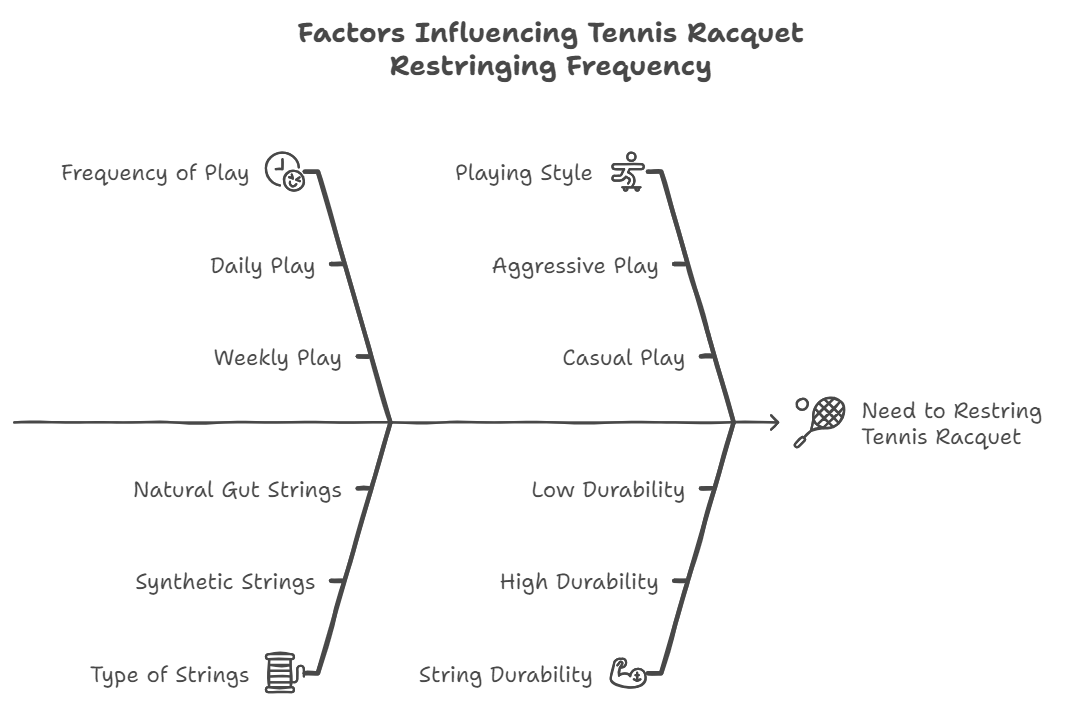
Signs that your racquet needs restringing
There are several indicators that your tennis racket may need to be re-stringing, especially if you notice changes in the tension of your racquet strings. If you notice a decrease in power or control during play, or if the strings appear frayed or noticeably loose, it’s time to consider restringing to maintain your skill level. Additionally, if you can’t remember the last time you had your racquet re-string, it’s probably overdue for a fresh set of strings to improve how the racquet feels.
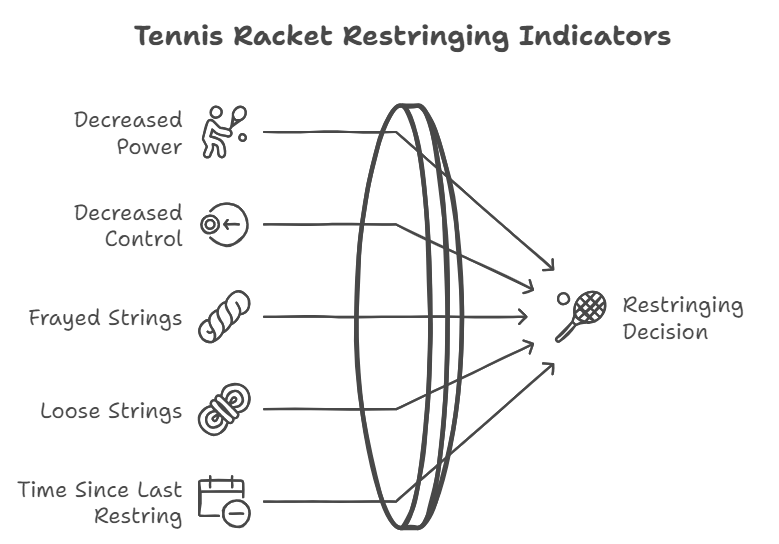
Frequency based on playing habits
A general rule of thumb is to restring your racquet as many times per year as you play per week, as this may help prevent string breakage. For example, if you play tennis twice a week, you should aim to restring your racquet at least three times a year for optimal performance. However, if you’re an avid player or compete regularly, you may need to restring more frequently to maintain optimal performance and avoid any issues with broken strings.
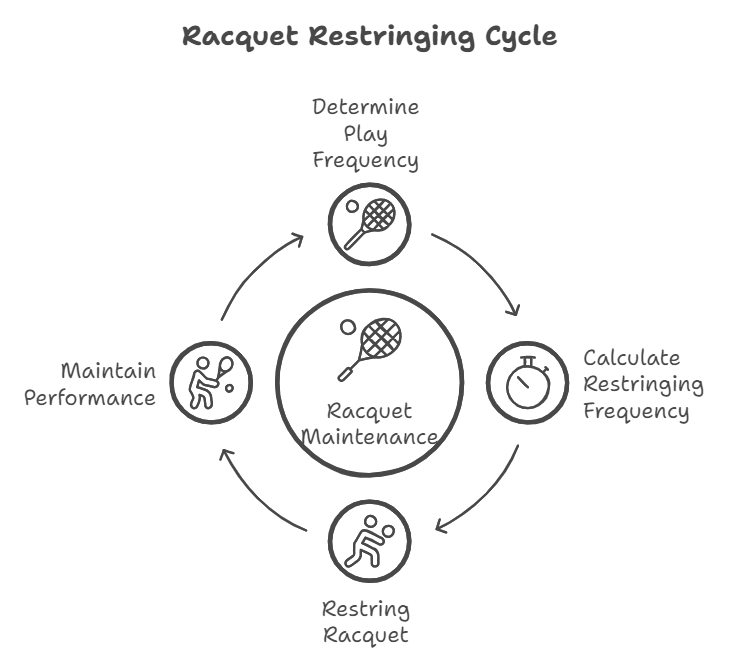
Impact of string type on restringing intervals
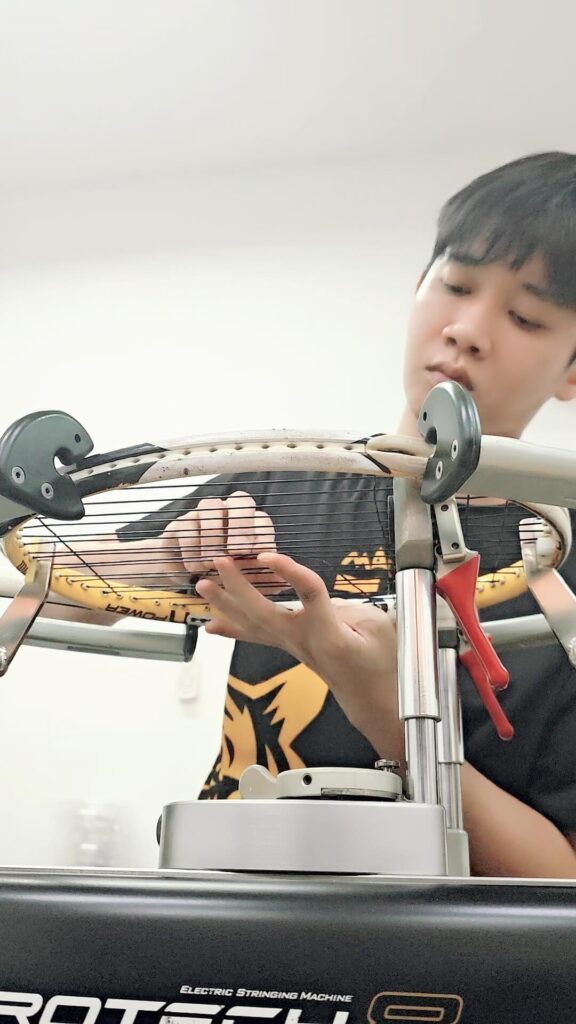
The type of string you use can significantly affect how often you need to restring your racquet. Natural gut strings, while offering excellent playability, tend to lose tension faster and may require more frequent restringing. Synthetic gut and multifilament strings generally have moderate durability, while polyester strings are known for their longevity and may require less frequent restringing, making them a good choice for another player.
What tools and materials do I need for racquet restringing?
Before you begin the restringing process, it’s essential to gather all the necessary tools and materials, including those that can skip the grommet for easier setup. Having the right equipment will ensure a smoother and more efficient stringing experience.
Essential stringing tools
To restring your tennis racquet, you’ll need a few key tools that have got you covered for any situation you might encounter. These include a stringing machine (which can be purchased or rented from local tennis shops), a pair of string cutters or scissors, pliers, and an awl for clearing obstructed grommets, all essential for re-stringing. Some players also prefer to use a starting clamp to hold the initial knot in place for an efficient service, especially when they hit the courts frequently.

Choosing the right tennis strings
Selecting the appropriate tennis strings is crucial for achieving your desired playing characteristics. Consider factors such as durability, power, control, and comfort when choosing string material, as these can also have an impact on your game. Popular options include synthetic gut, multifilament, polyester, and natural gut strings, each catering to different player preferences and skill levels, so knowing your options can help you choose wisely. Each type offers different benefits and specific tension characteristics, so it’s essential to experiment and find the best fit for your playing style.
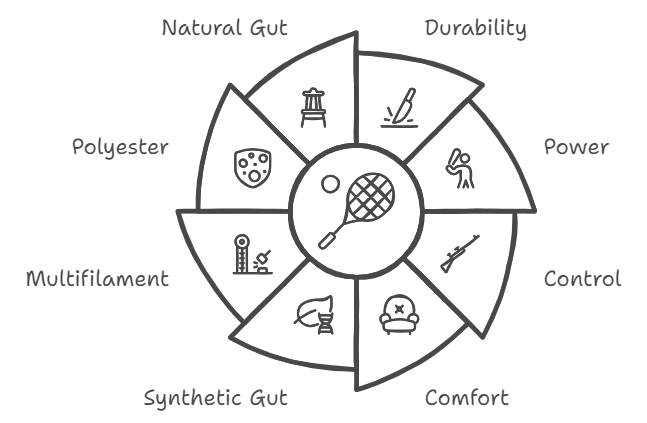
Additional supplies for the restringing process
In addition to the main tools and strings, you may want to have some supplementary items on hand for your tennis racquet re-stringing process to ensure everything is ready when it’s time for a restring. These can include a grommet strip (in case any grommets need replacement), string savers to protect high-wear areas, and a tension calibrator to ensure accurate string tension throughout the process, especially for expert tennis players.

How do I prepare my tennis racquet for restringing?
Proper preparation is key to a successful restringing job. Taking the time to prepare your racquet will help ensure a clean and efficient re-stringing process, allowing you to get it back on the court faster.
Removing old strings
Begin by cutting out the old strings from your racquet. Use string cutters or scissors to carefully cut through the strings, being cautious not to damage the frame or grommets. Remove all string fragments from the racquet, ensuring that no debris remains in the string holes, as this can impact the quality of your stringing service.

Inspecting the racquet frame
Once the old strings are removed, thoroughly inspect the racquet frame for any signs of damage or wear to ensure it’s ready for re-stringing within the appropriate tension range. Look for cracks, dents, or other structural issues that may affect the re-stringing process or the racquet’s performance, as these can impact the times you play and lead to broken strings. If you notice any significant damage, it may be best to consult a professional or consider replacing the racquet, particularly if you play a number of times you play each week.
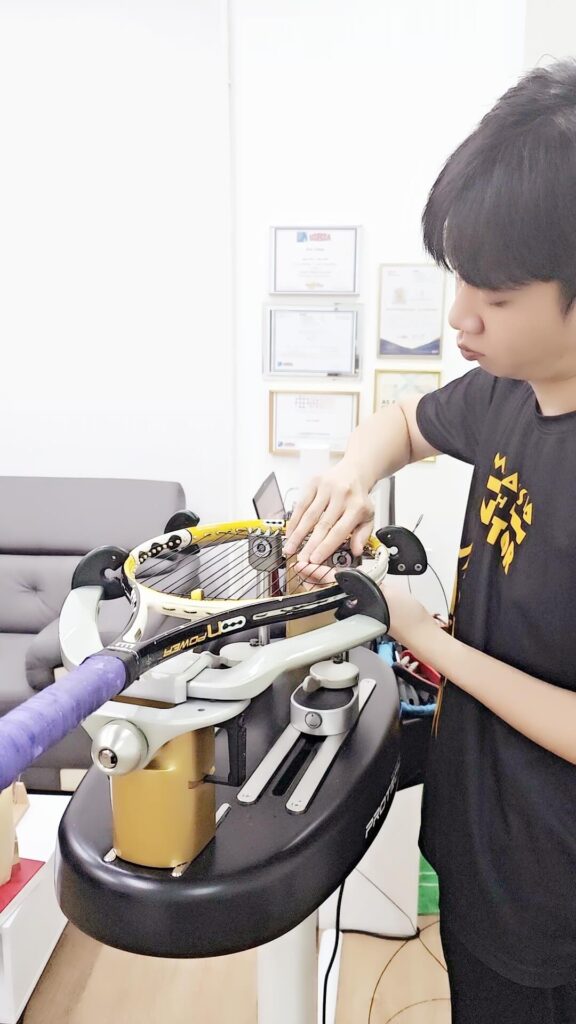
Cleaning and maintaining the grommets
Examine the grommets (the small plastic or metal inserts that protect the frame where the strings pass through) for any signs of wear or damage. Clean out any dirt or debris from the grommets using an awl or a small brush. If any grommets are damaged or missing, replace them with new ones to ensure proper string protection and tension distribution, as this may help prevent breakage.
What is the step-by-step process for restringing a tennis racquet?
Now that you’ve prepared your racquet and gathered all the necessary materials, including a dampener, it’s time to begin the restringing process. Follow these steps carefully to ensure a proper re-string job and maintain the tension of your racquet strings.
Stringing the main strings
Start by threading the main strings through the racquet frame, beginning at the throat and working your way up to the head. Secure the starting knot and use the stringing machine to apply the desired specific tension to each string, as this is crucial for optimal performance. Pay close attention to the stringing pattern specific to your racquet model, as this can vary between different racquets and affect how well you string your racquet.
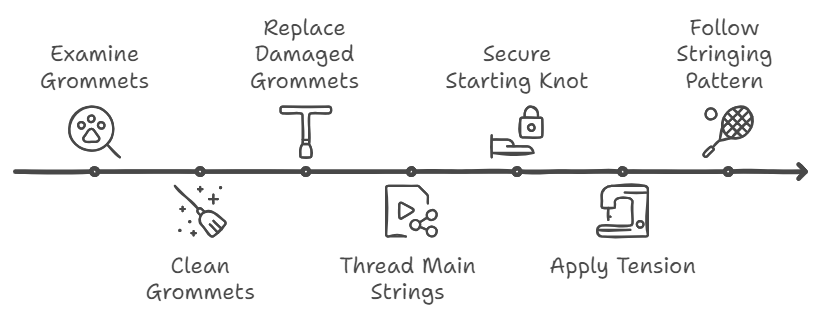
Weaving and tensioning the cross strings
Once the main strings are in place, begin weaving the cross strings through the main strings of your tennis racket. Start at the head of the racquet and work your way down to the throat, paying attention to the notch that guides the string placement, ensuring you achieve the desired specific tension. Use the stringing machine to apply tension to each cross string, ensuring consistent tension throughout the process. Take care to maintain a clean and even weave pattern for optimal performance, as this can also provide more control during your matches.
Tying off and finishing the string job
After all the strings are in place and tensioned, tie off the final knot securely. Trim any excess string, leaving a small tail to prevent the knot from slipping, as this may help avoid potential breakage. Double-check all knots and string tensions to ensure everything is secure and consistent, as this affects how the racquet feels during play and may prevent breakage. Finally, remove the racquet from the stringing machine and give it a thorough inspection to ensure it meets expert tennis standards, as this may be time well spent to help you play well.
How do I choose the right string tension for my tennis racquet?
Selecting the appropriate string tension is crucial for achieving your desired playing characteristics and may help you choose the right setup to play well. The right tension can significantly impact your performance on the court, so be sure to adjust it according to the number of times you play.
Understanding string tension effects on play
Lower string tensions generally provide more power and a larger sweet spot but may offer less control. Higher tensions typically offer increased control and precision but can reduce power and may be less forgiving on off-center hits. Finding the right balance between power and control is key to optimizing your racquet’s performance.
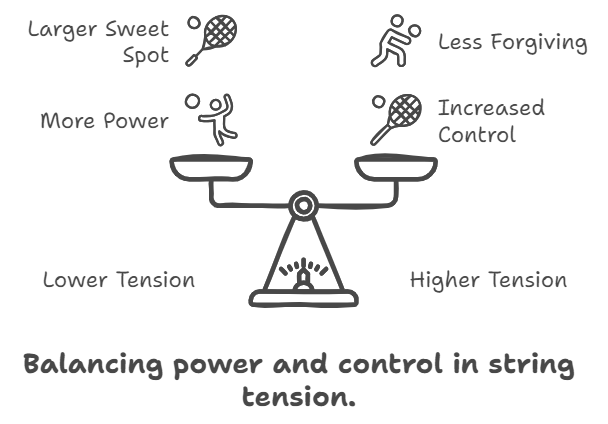
Recommended tensions for different playing styles
Beginners and players who prefer more power may benefit from lower tensions, typically ranging from 50-55 pounds, to enhance how the racquet feels during play. Intermediate players often find a middle ground between 55-60 pounds suitable for their tennis racket. Advanced players and those who prioritize control may opt for higher tensions, sometimes exceeding 60 pounds, but they should also be aware of the potential for broken strings. It’s important to experiment with different tensions to find what works best for your playing style.
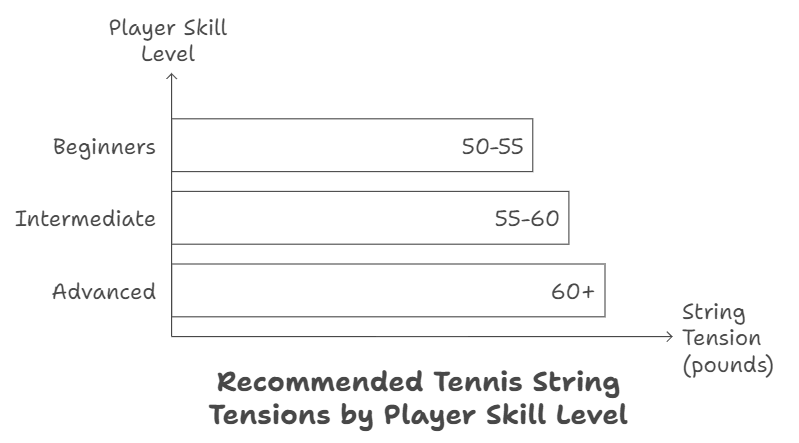
Adjusting tension for various string types
Different string types may require adjustments in tension to achieve optimal performance, so consider how often to restring your racquet back based on your playing frequency, especially if you play many times a year. For example, natural gut strings tend to maintain tension well and may be strung at slightly higher tensions, providing the elasticity that enhances performance. Polyester strings, known for their low power and high control, are often strung at lower tensions to compensate for their stiffness. Synthetic gut and multifilament strings typically perform well at mid-range tensions.
What are the different types of tennis strings and their benefits?
Understanding the characteristics of various string types can help you make an informed decision when choosing strings for your racquet.
Natural gut vs. synthetic strings
Natural gut strings, made from cow intestines, offer excellent playability, power, and feel for your tennis racket. They are known for their ability to maintain tension and provide a comfortable playing experience. However, they are also the most expensive option and less durable than synthetic alternatives, which may lead to more frequent breakage. Synthetic strings, such as synthetic gut and multifilament strings, aim to mimic the properties of natural gut while offering improved durability and affordability for players of all skill levels.
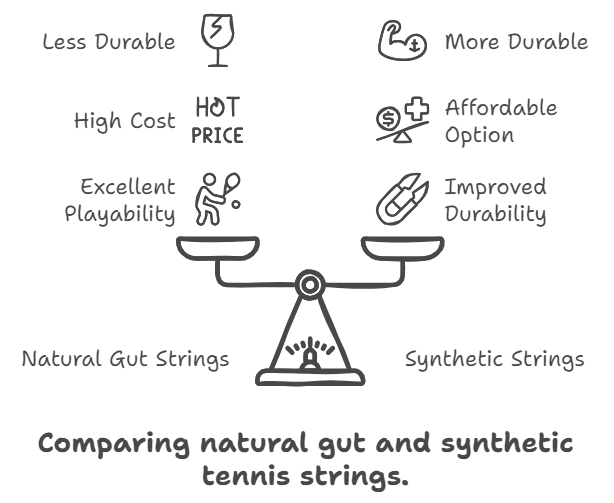
Polyester strings and their characteristics
Polyester strings have gained popularity among advanced players and heavy hitters due to their specific tension capabilities. They offer excellent durability, spin potential, and control, which can provide more control during matches. However, they can be less comfortable and may provide less power compared to other string types. Polyester strings are often used by players who generate their own power and prioritize control and spin in their game.

Hybrid string setups and their advantages
Hybrid string setups combine two different types of strings in a single tennis racket, typically using one type for the main strings and another for the cross strings. This approach allows players to benefit from the characteristics of both string types. For example, using a durable polyester for the main strings and a more comfortable synthetic gut for the crosses can provide a balance of control, spin, and comfort.
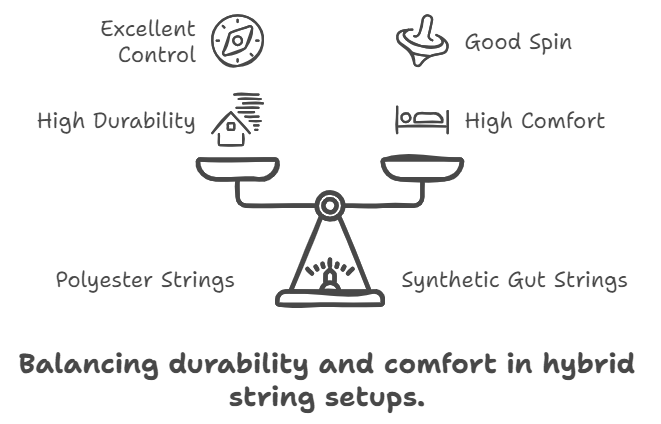
How can I maintain my newly restrung tennis racquet?
Proper maintenance of your newly strung racquet can help prolong the life of your strings and ensure consistent performance on the court, reducing the risk of breakage.
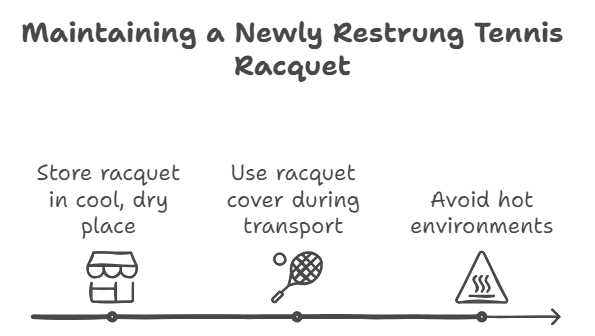
Proper storage and transportation
Store your racquet in a cool, dry place away from direct sunlight and extreme temperatures to ensure the longevity of your tennis racquet stringing, especially if you plan to restring it three times a year. Use a racquet cover or bag to protect it during transportation to ensure your racquet to get feels secure. Avoid leaving your racquet in hot cars or other environments that could cause the strings to lose tension prematurely, which may signal it’s time for a re-strung to keep them from becoming looser.
String care and maintenance tips
Regularly inspect your strings for signs of wear or fraying, as this may be time to consider a restring if you notice significant wear. Use a damp cloth to clean your strings after play, removing any dirt or debris that may have accumulated, especially if you notice any arm issues. Consider using string savers on high-wear areas to extend the life of your strings. Additionally, rotating your racquet in your bag can help distribute wear more evenly across the string bed.
When to seek professional restringing services
While learning to restring your own racquet can be rewarding, there are times when it’s best to seek professional stringing services to ensure optimal tension and performance, as improper tension may lead to string breakage. If you’re unsure about the process, lack the necessary tools, or have a valuable racquet that requires extra care, a professional stringer can ensure a high-quality string job. Many local tennis shops and sporting goods stores offer restringing services, often with quick turnaround times.

By following this comprehensive guide from Best Stringer Worldwide, you’ll be well-equipped to string a tennis racquet and maintain optimal performance on the court. Remember that practice makes perfect, and don’t be afraid to experiment with different string types and tensions to choose a tennis racket setup that is perfect for your game; you may want to get your racquet restrung regularly. Happy stringing!
Master Tennis Racquet Restringing: A Complete DIY Guide
This video provides a step-by-step guide on how to restring a tennis racquet. It covers everything from choosing the right strings and tension to the actual restringing process. Learn about different string types, maintenance tips, and how restringing affects your game. Perfect for tennis players of all levels looking to understand and maintain their equipment.
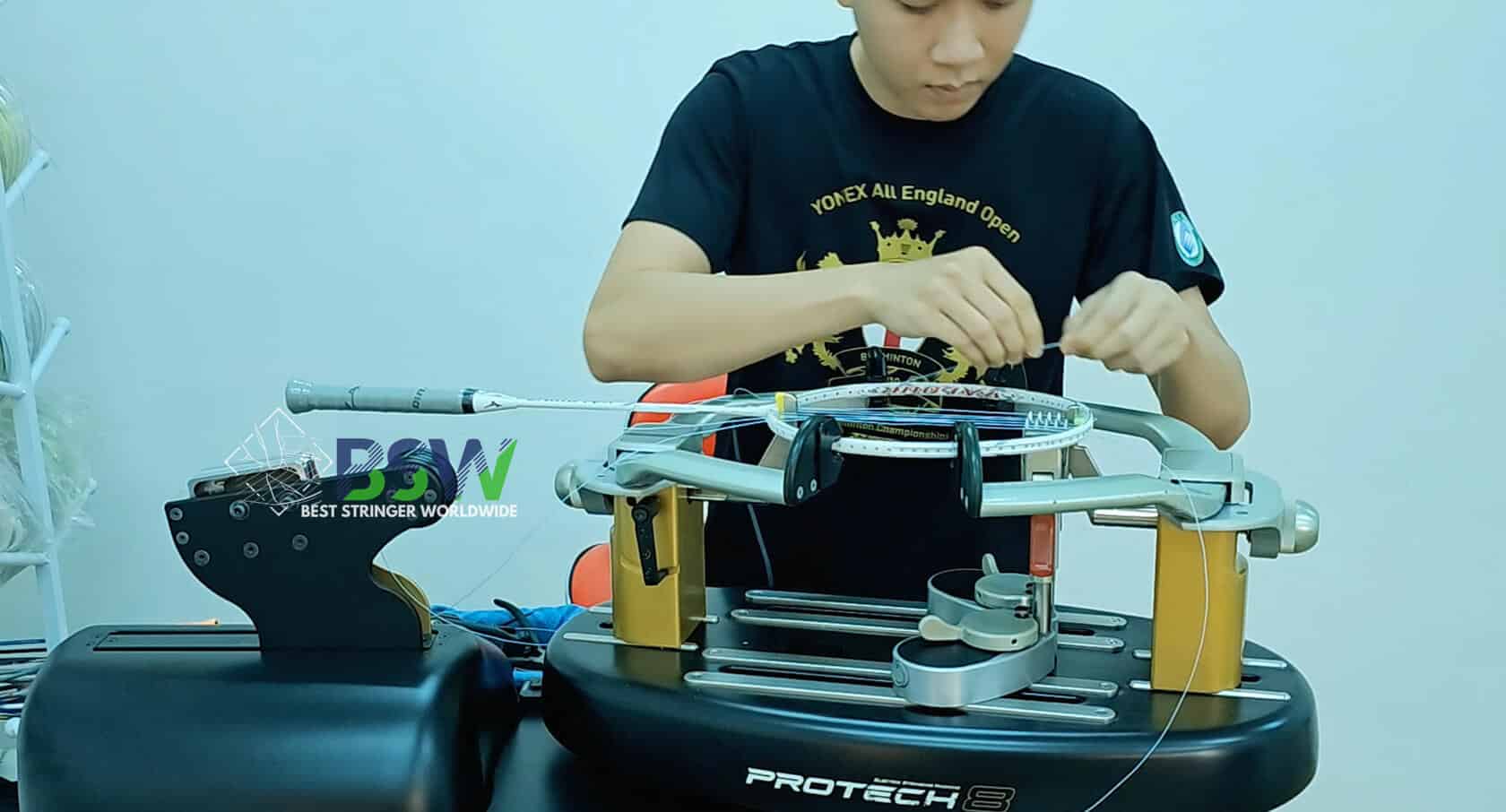
About Best Stringer Worldwide
Best Stringer Worldwide is a comprehensive badminton and tennis stringing education program. We provide in-depth training on stringing techniques, racquet technology, and player-specific customization. Our curriculum is designed to help stringers understand and meet the needs of all badminton players, from casual enthusiasts to competitive athletes.
Read More